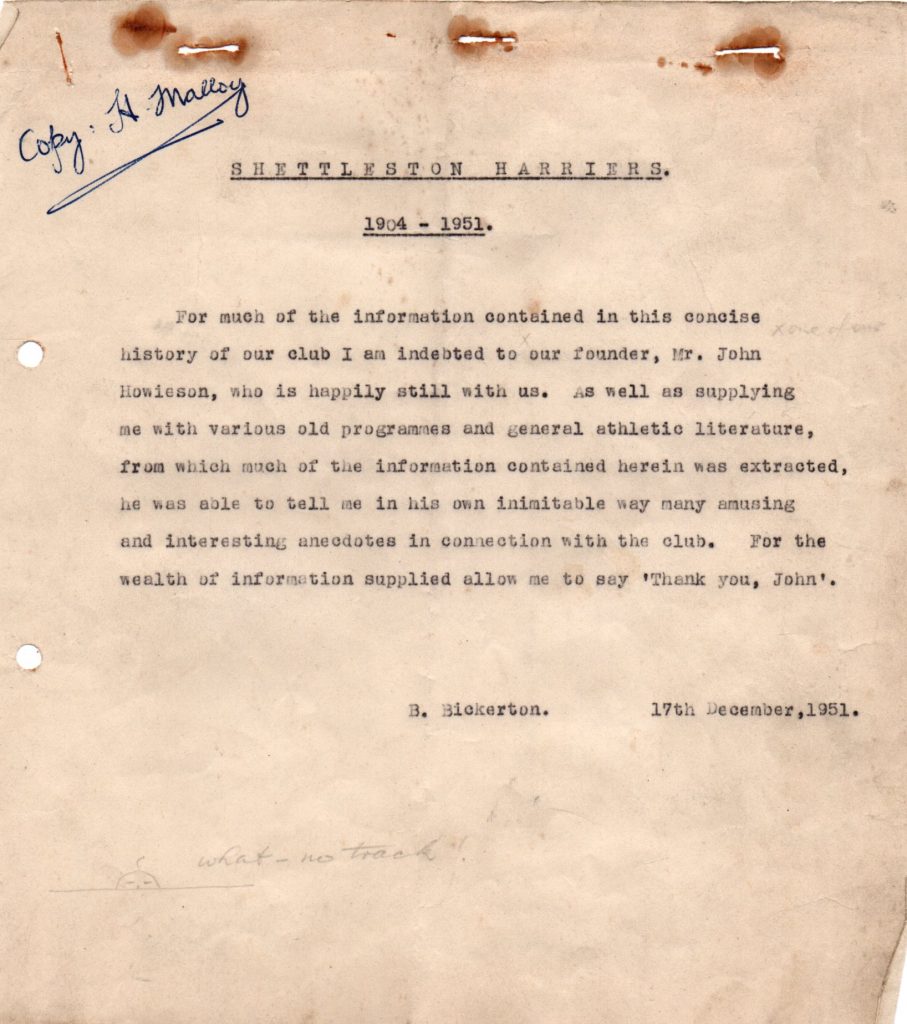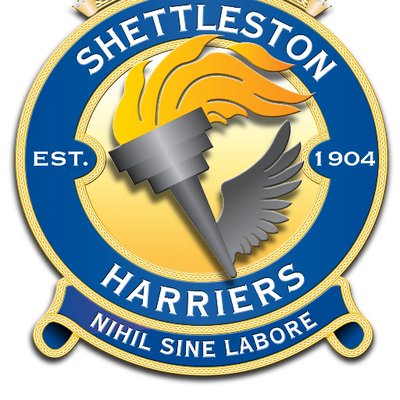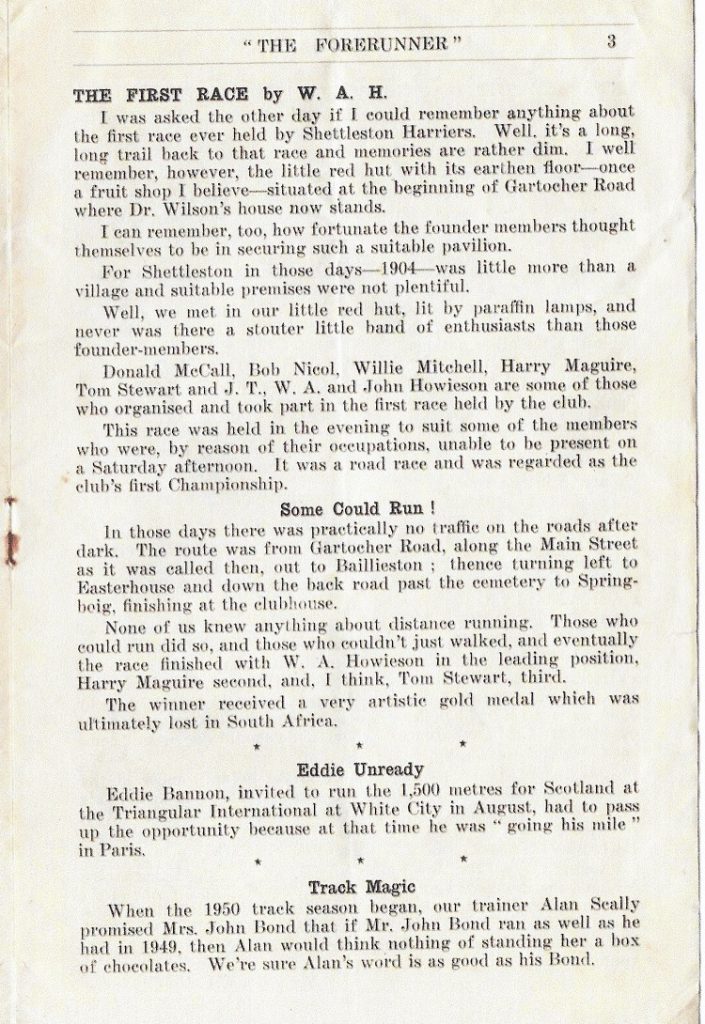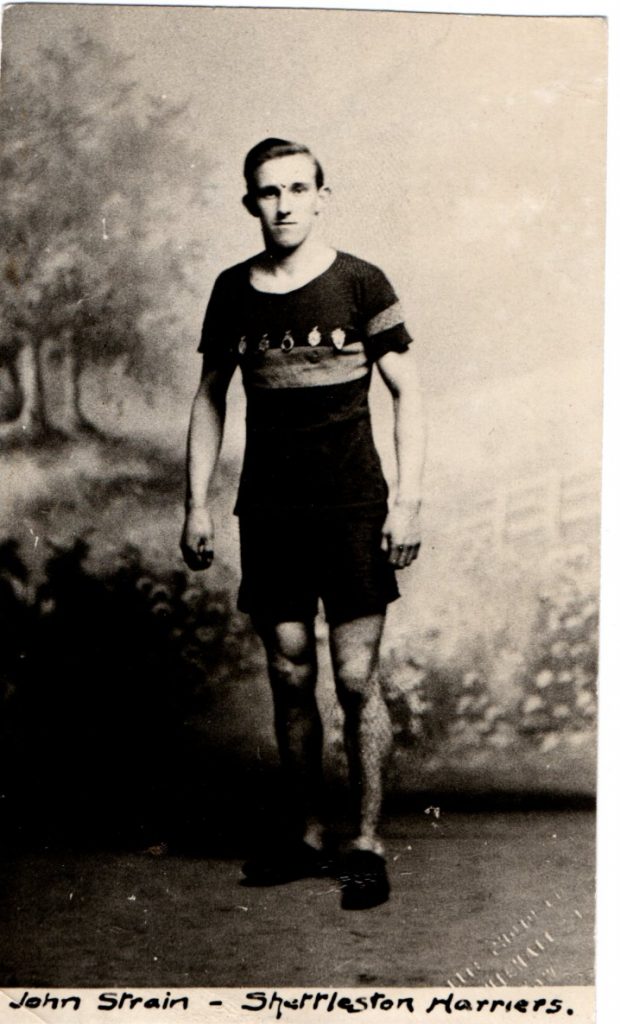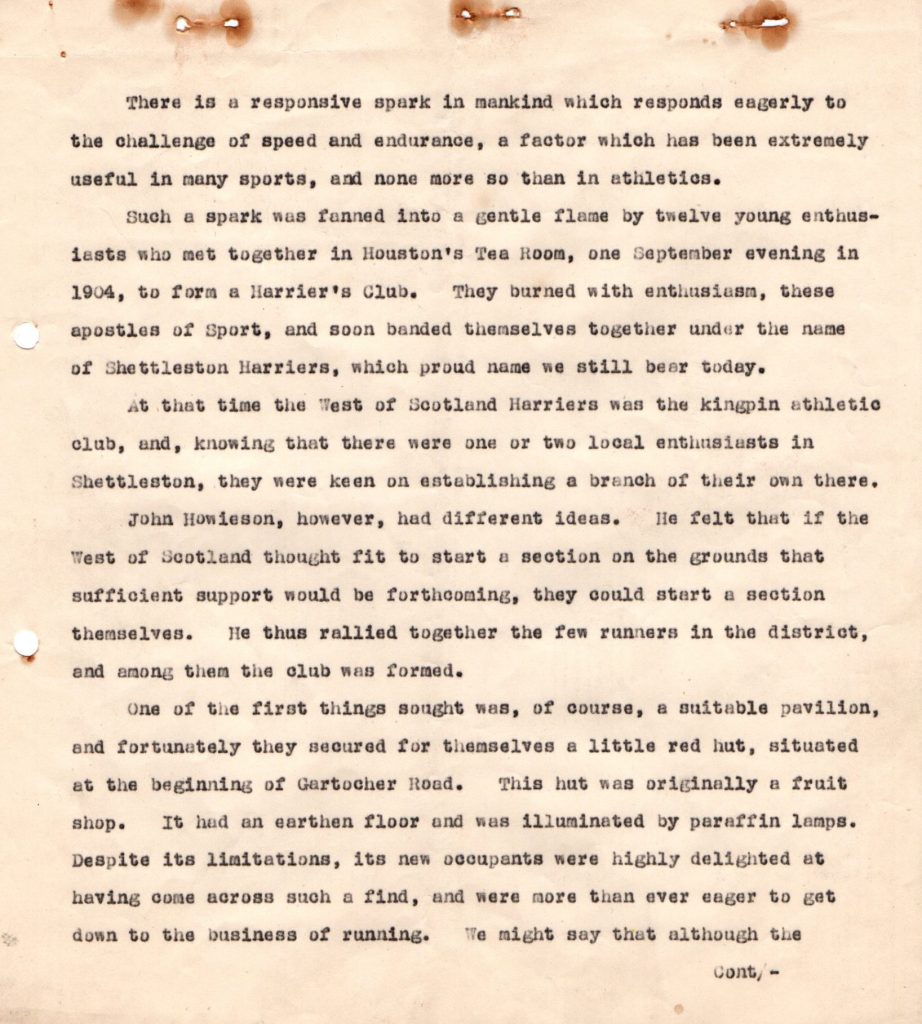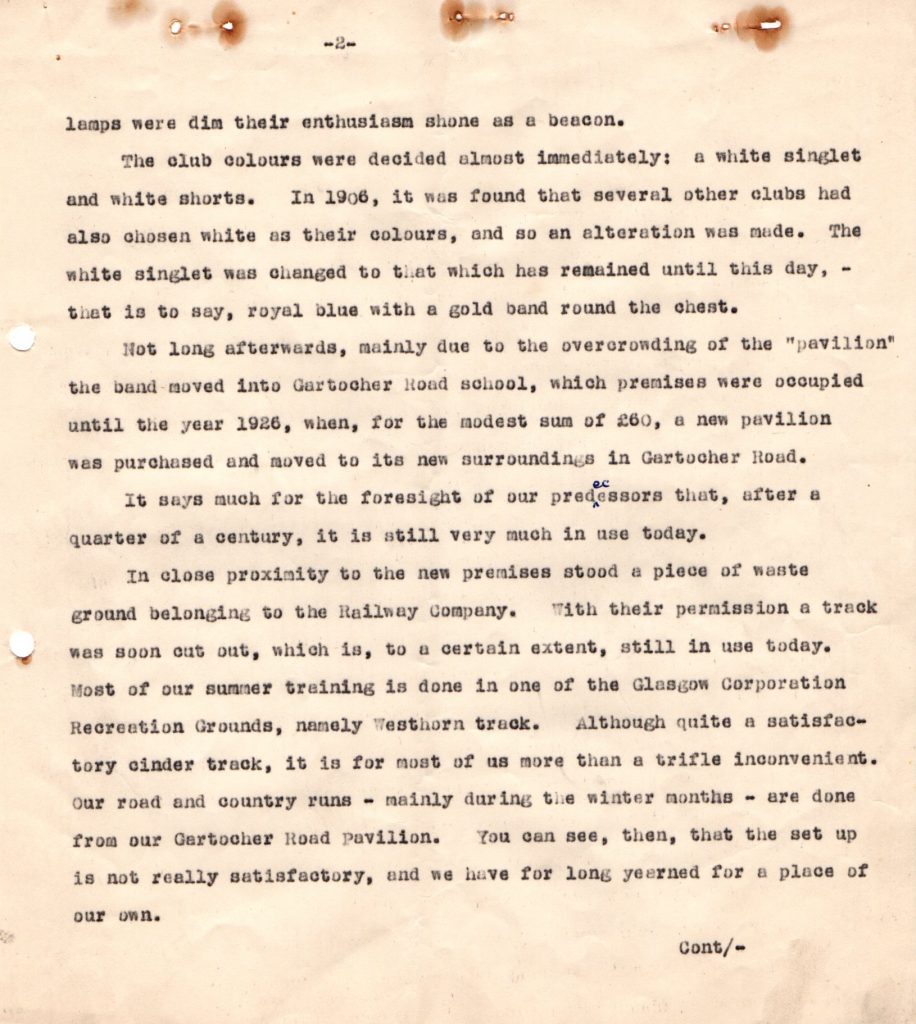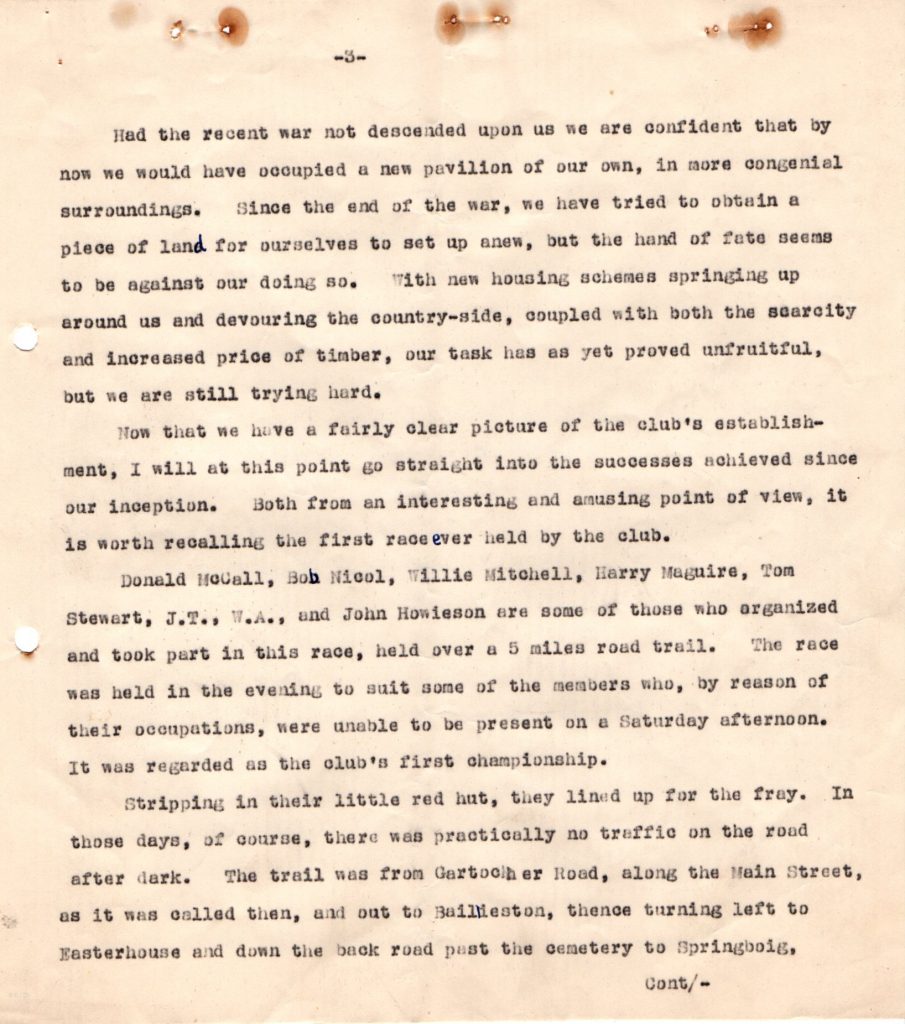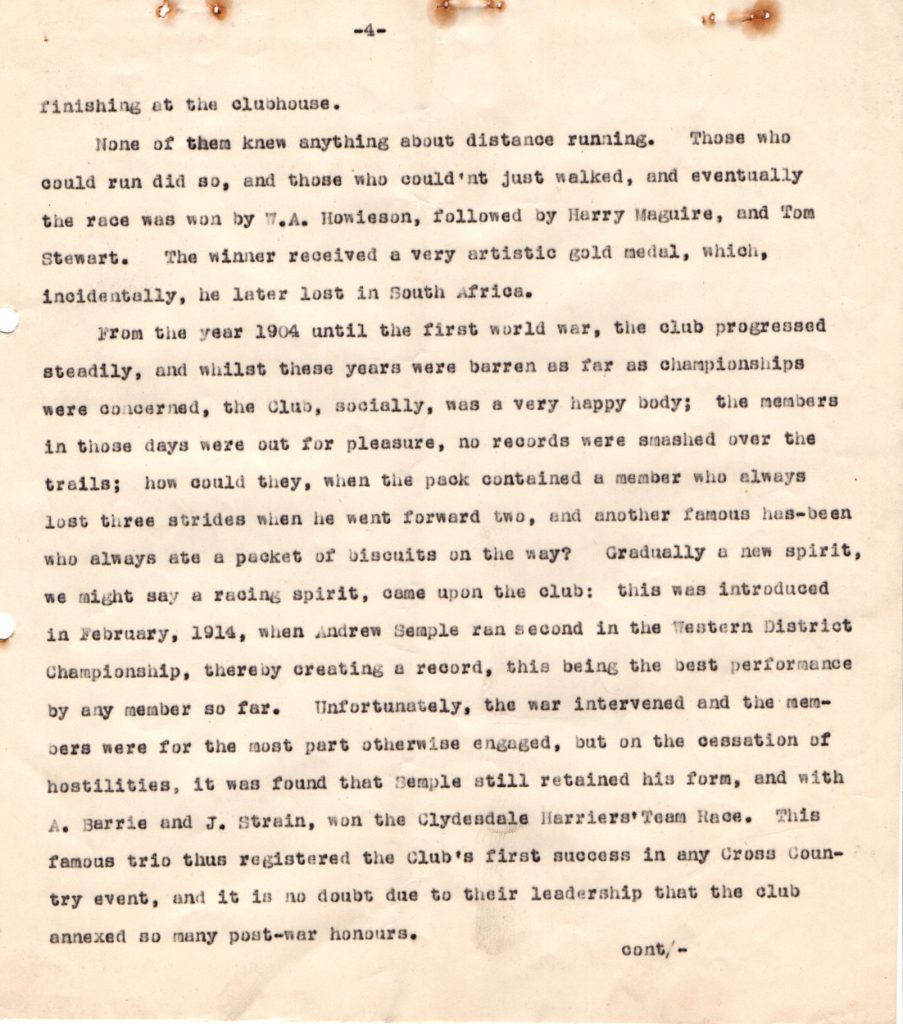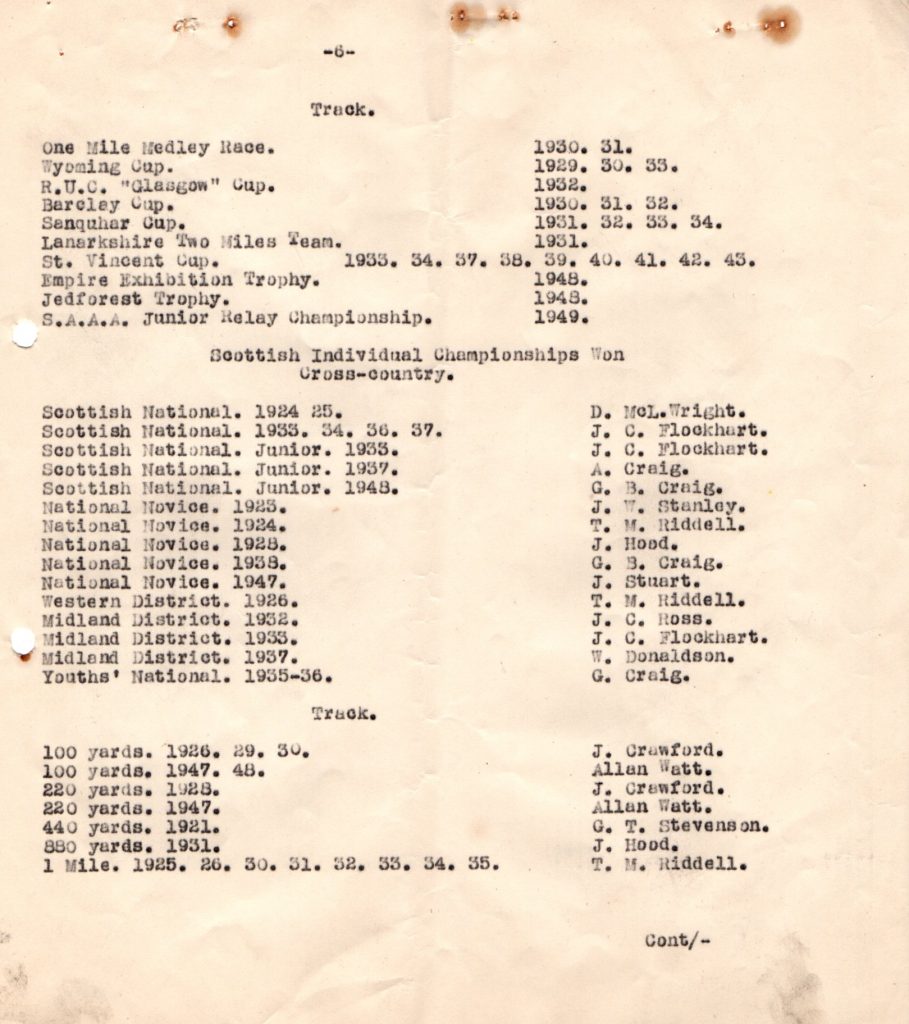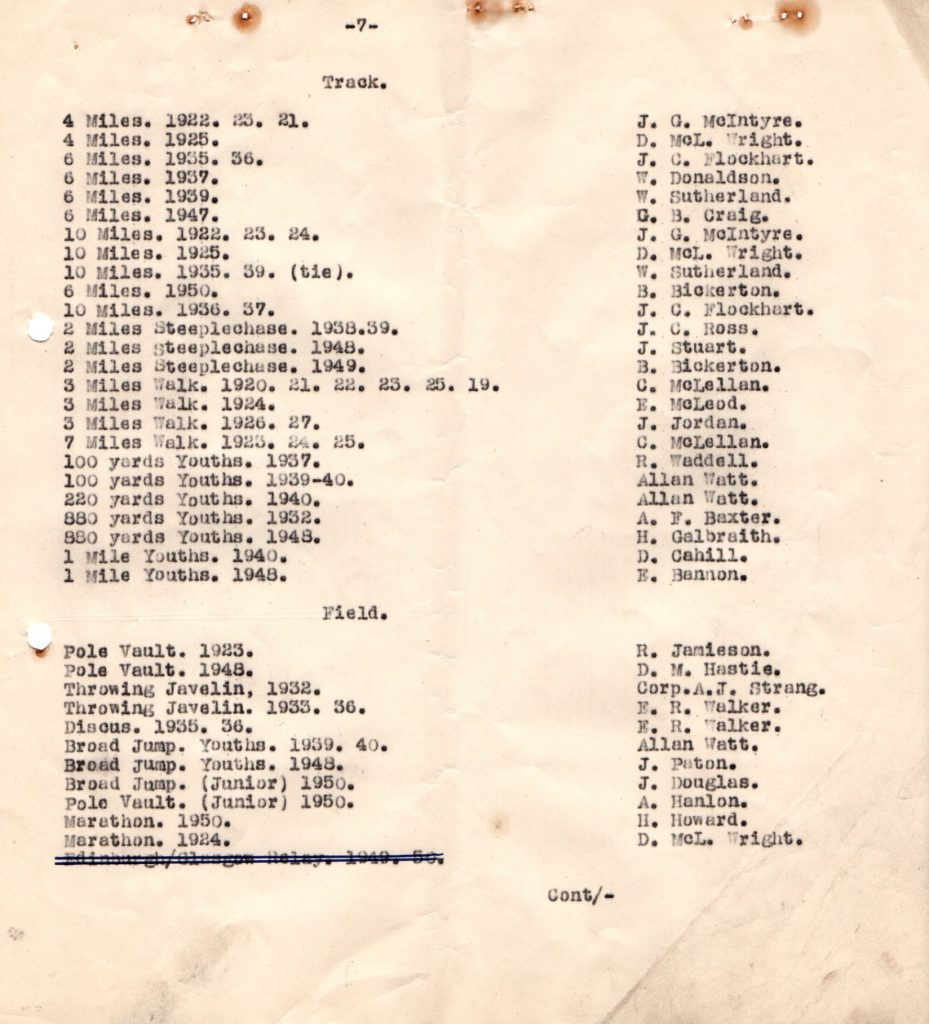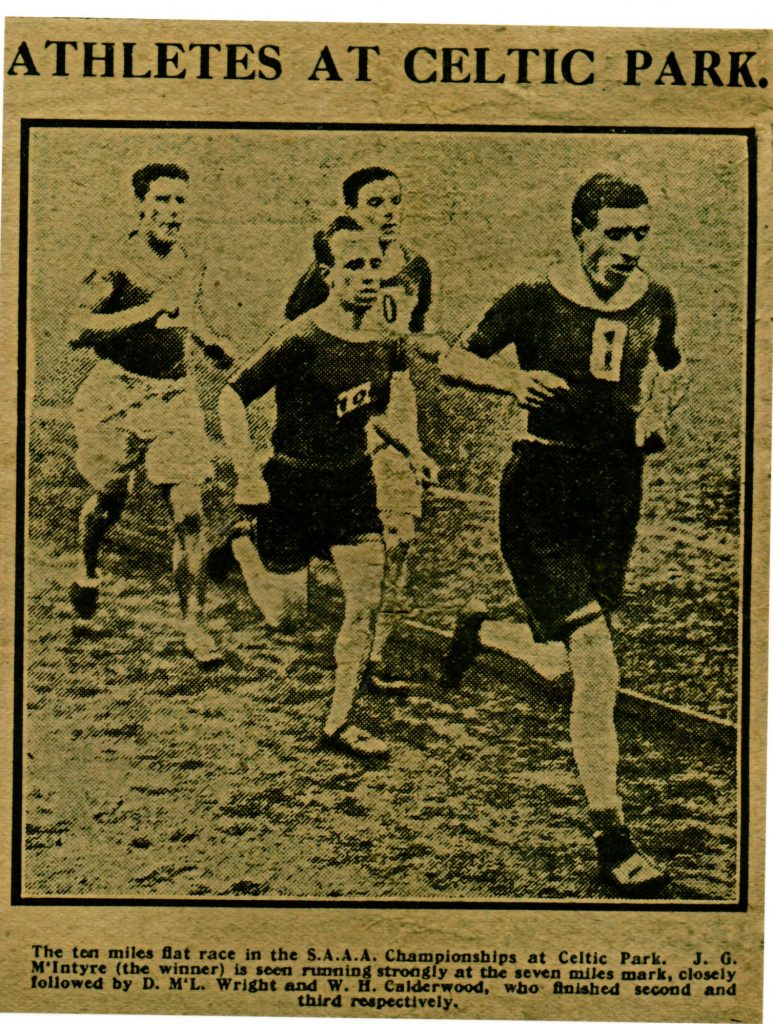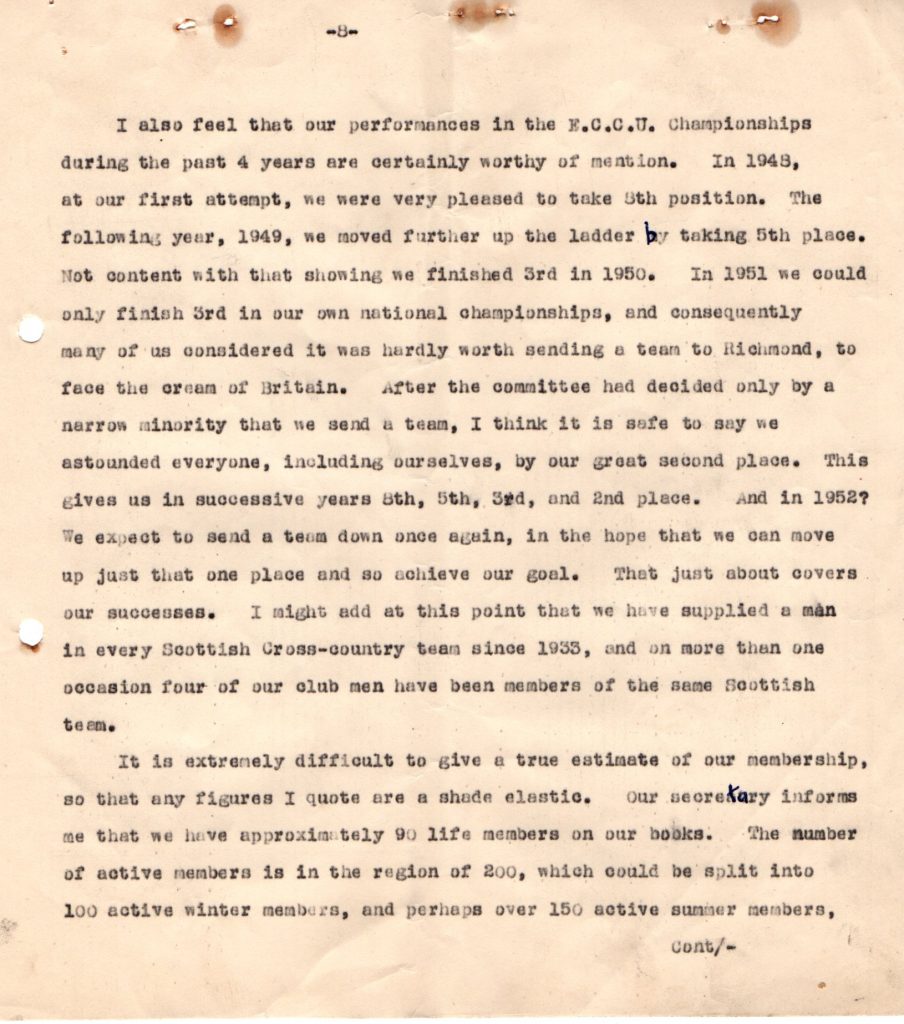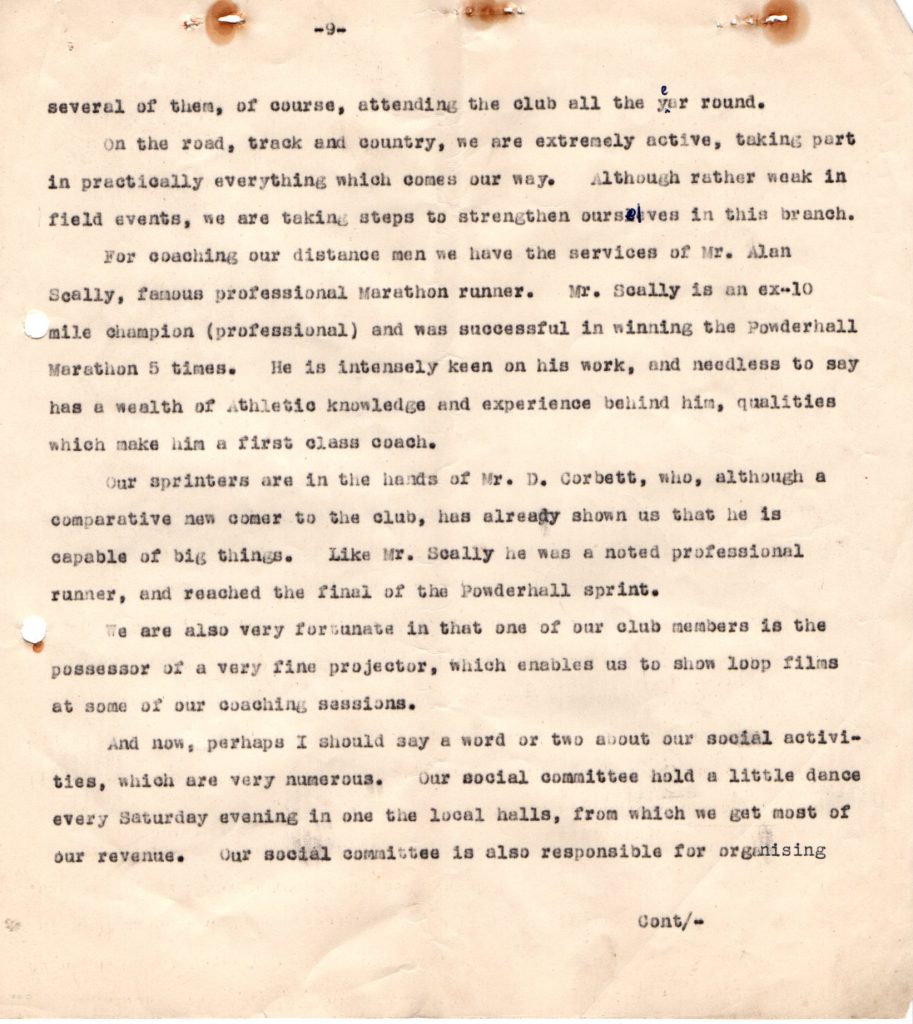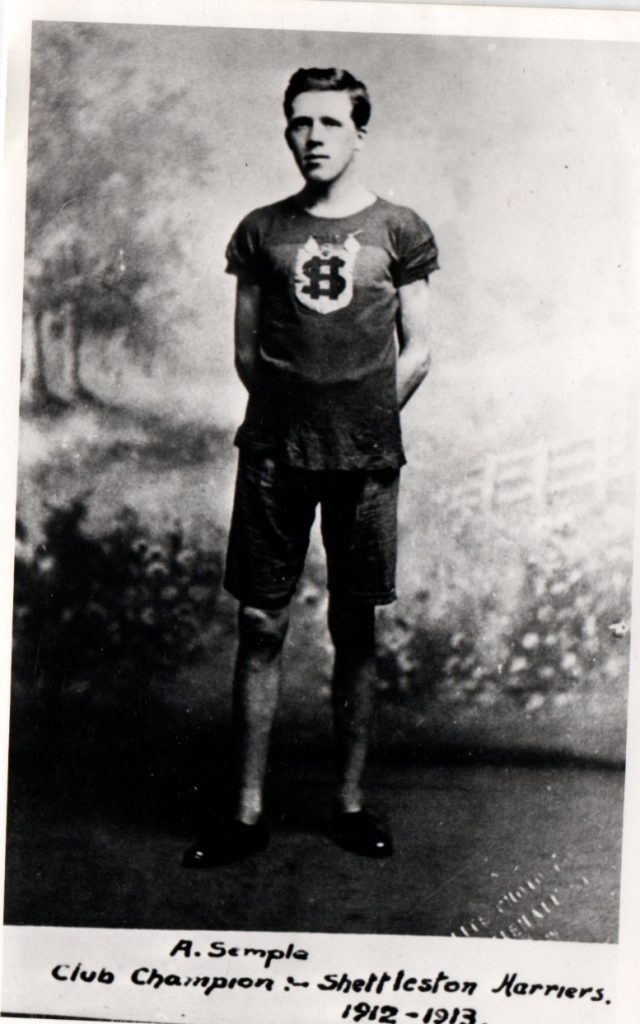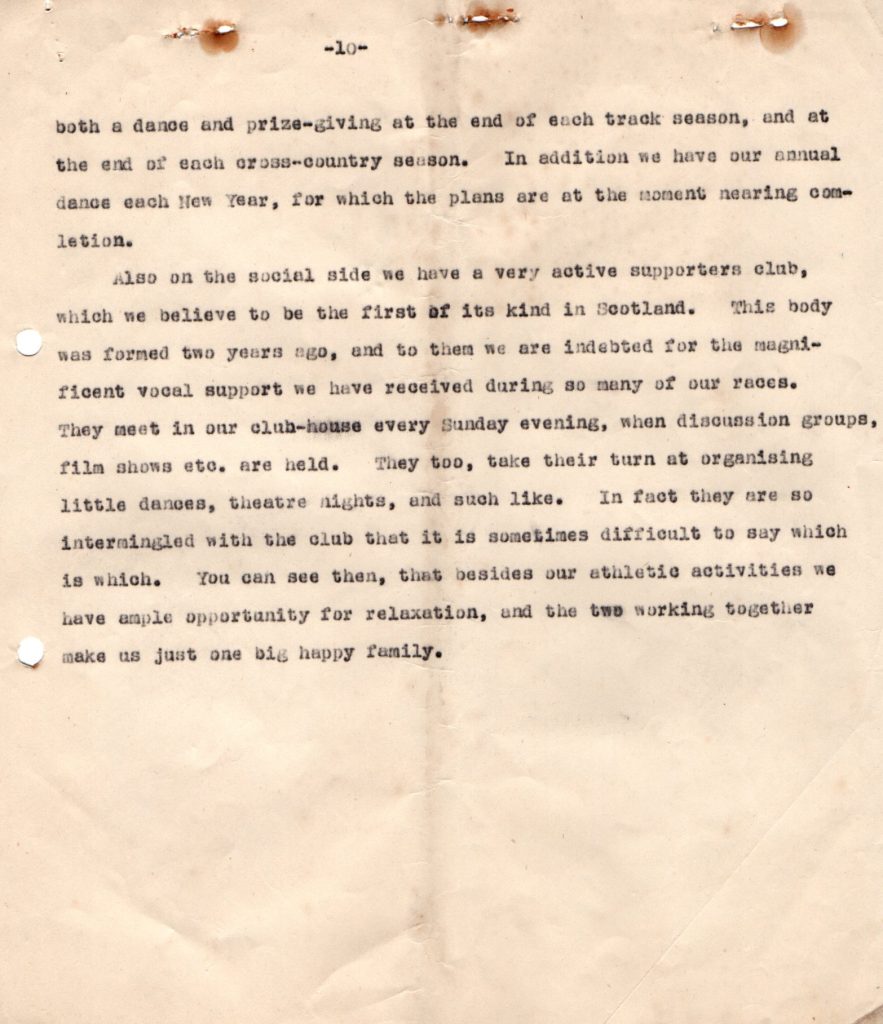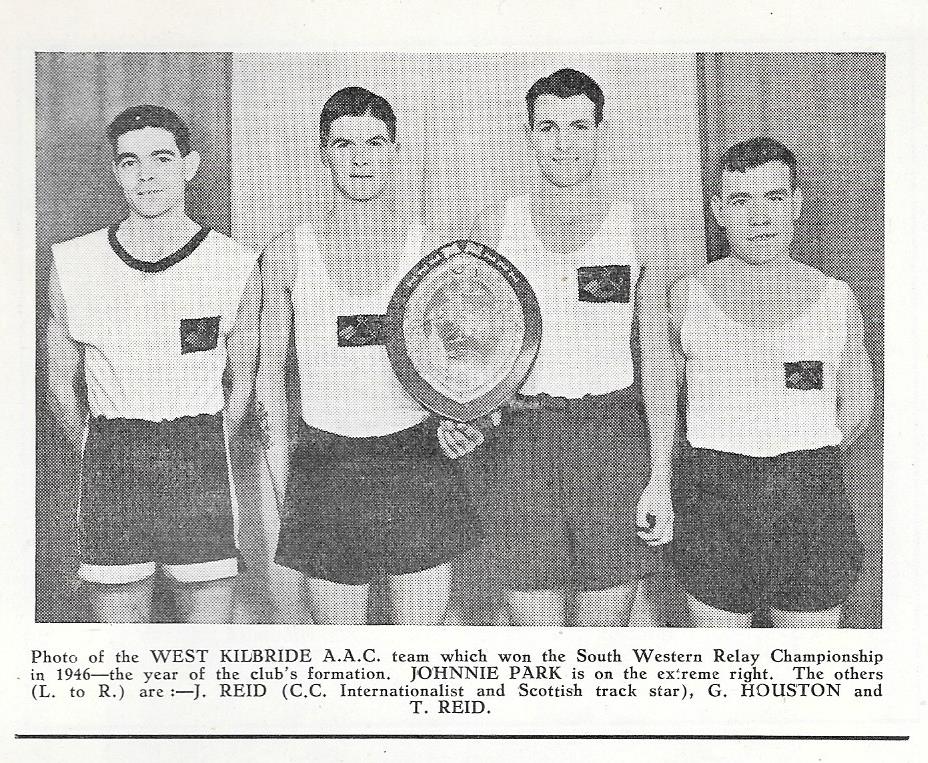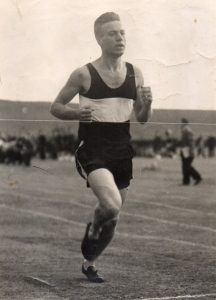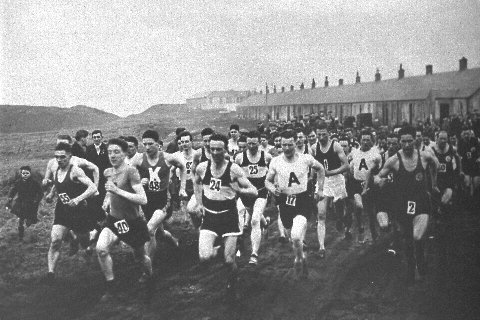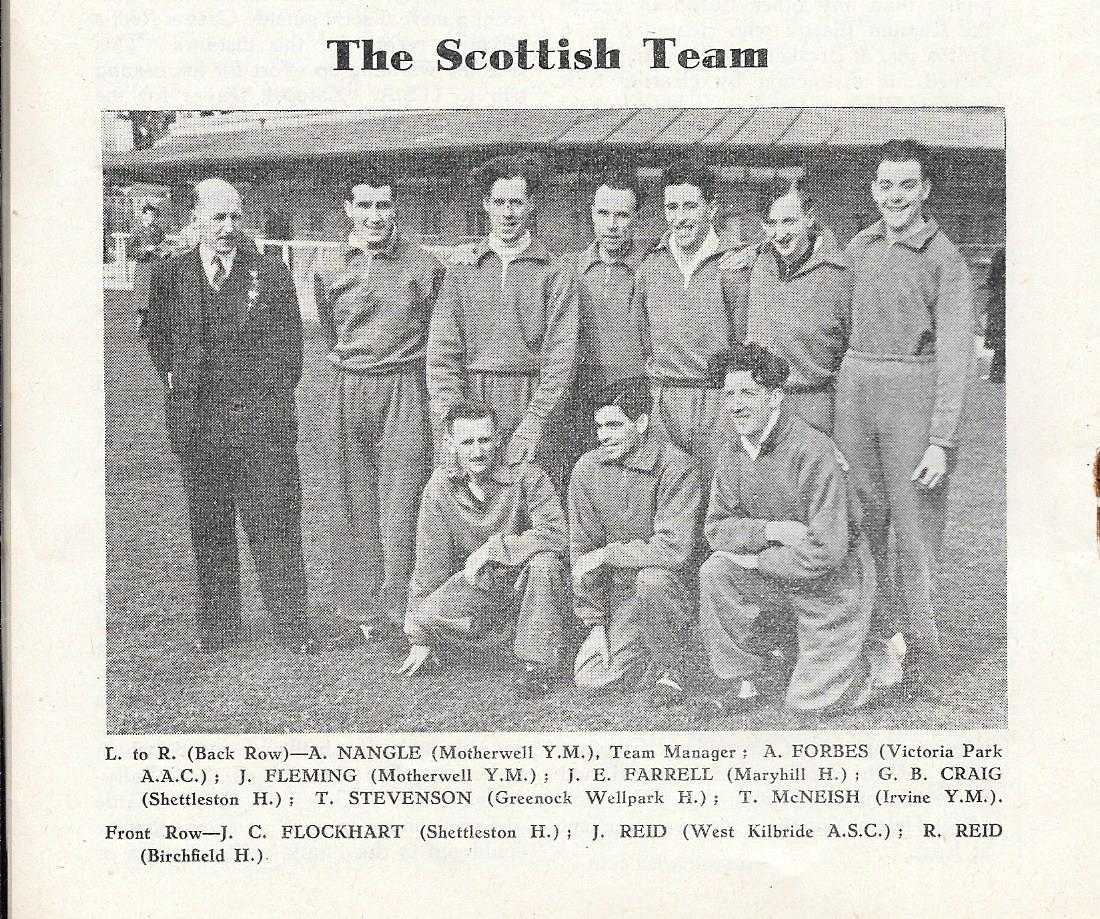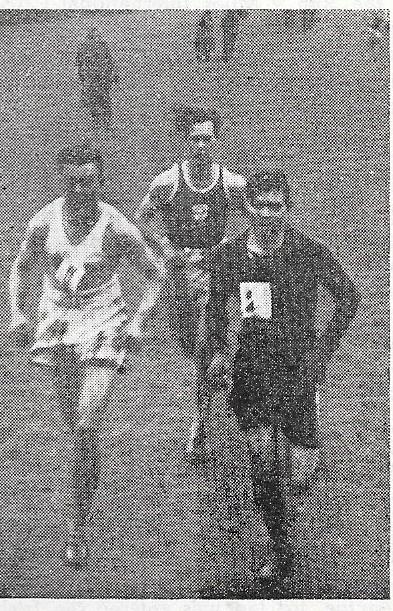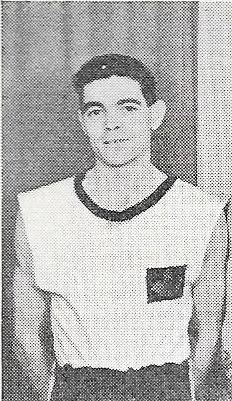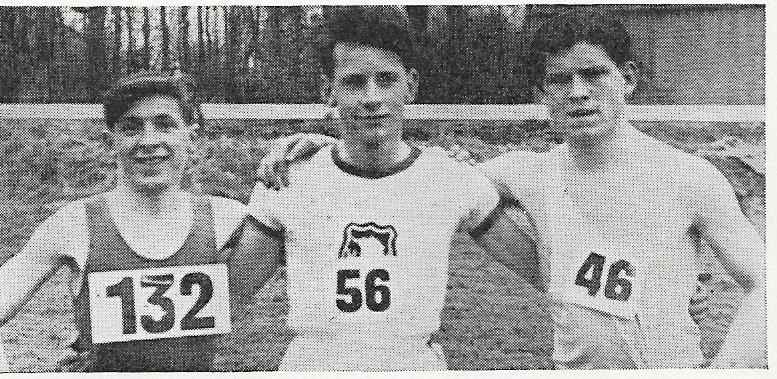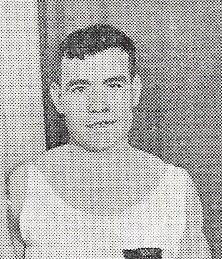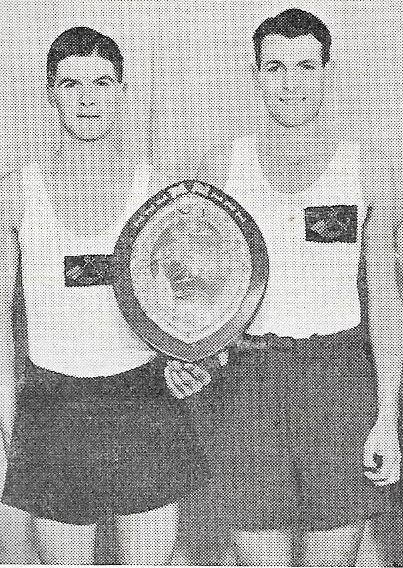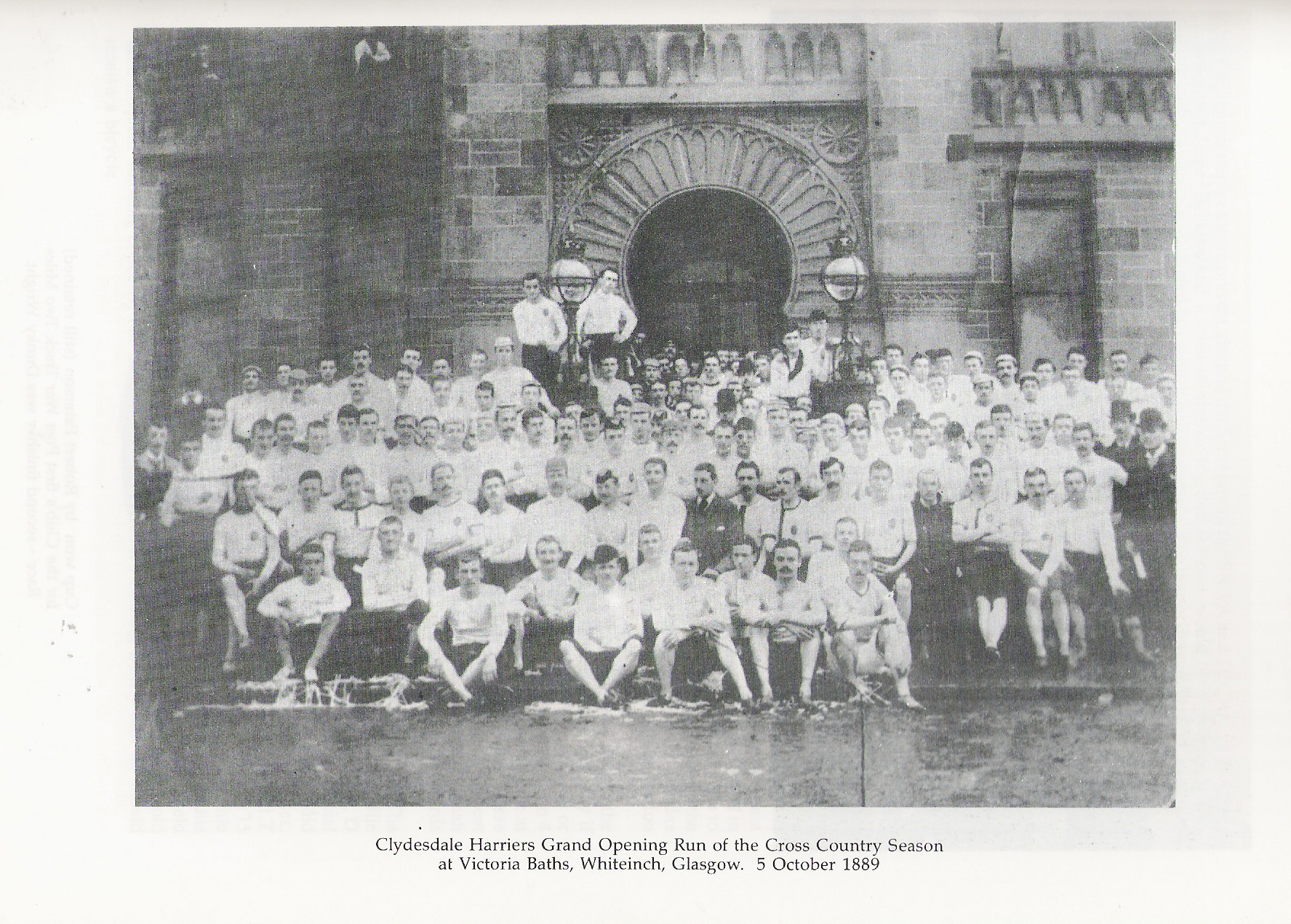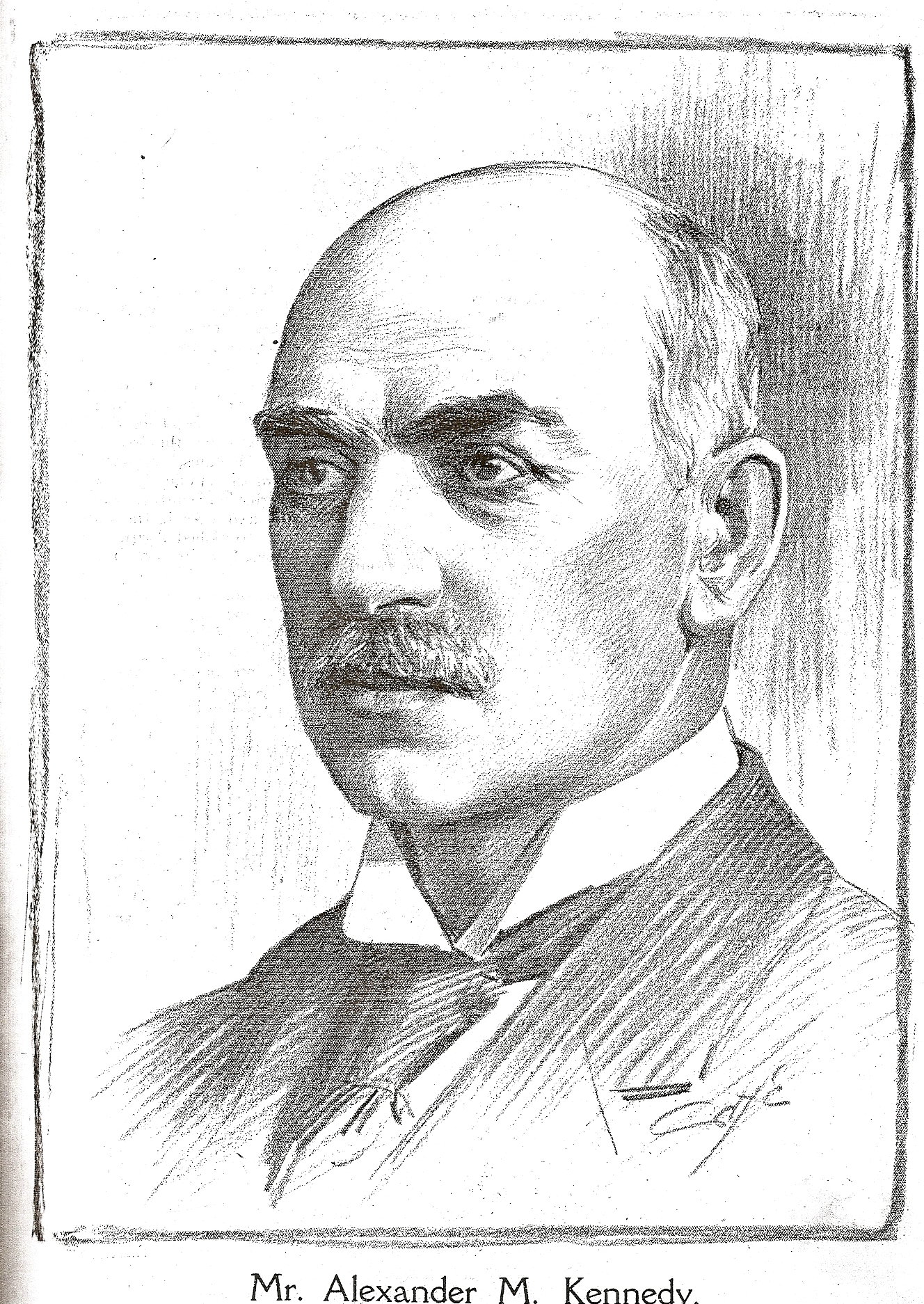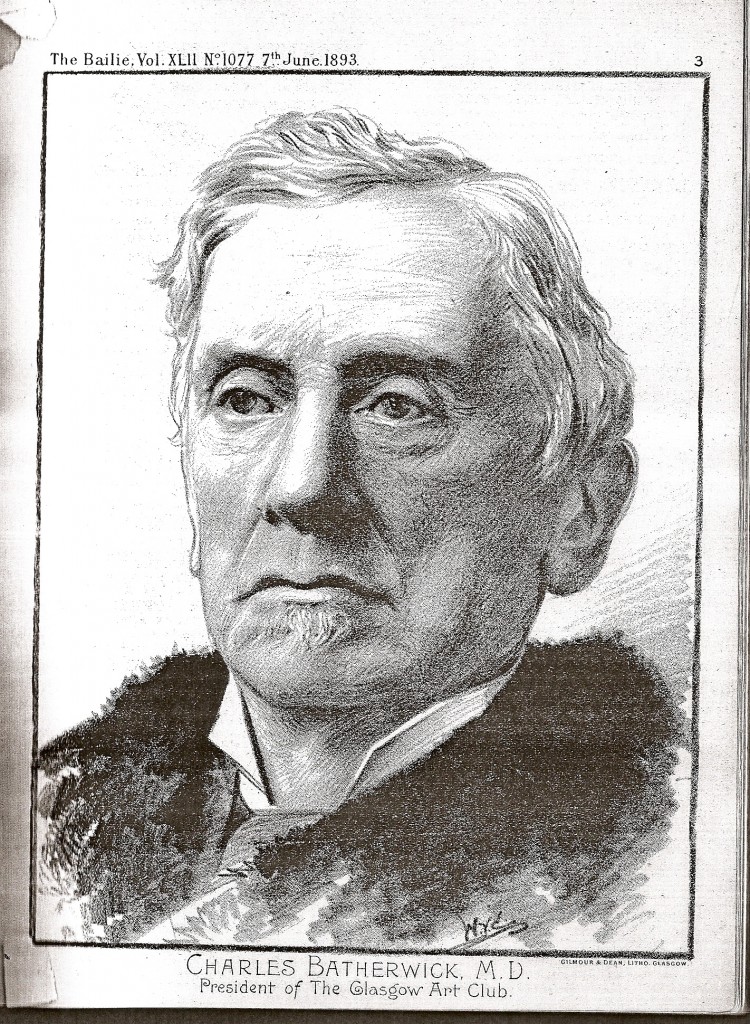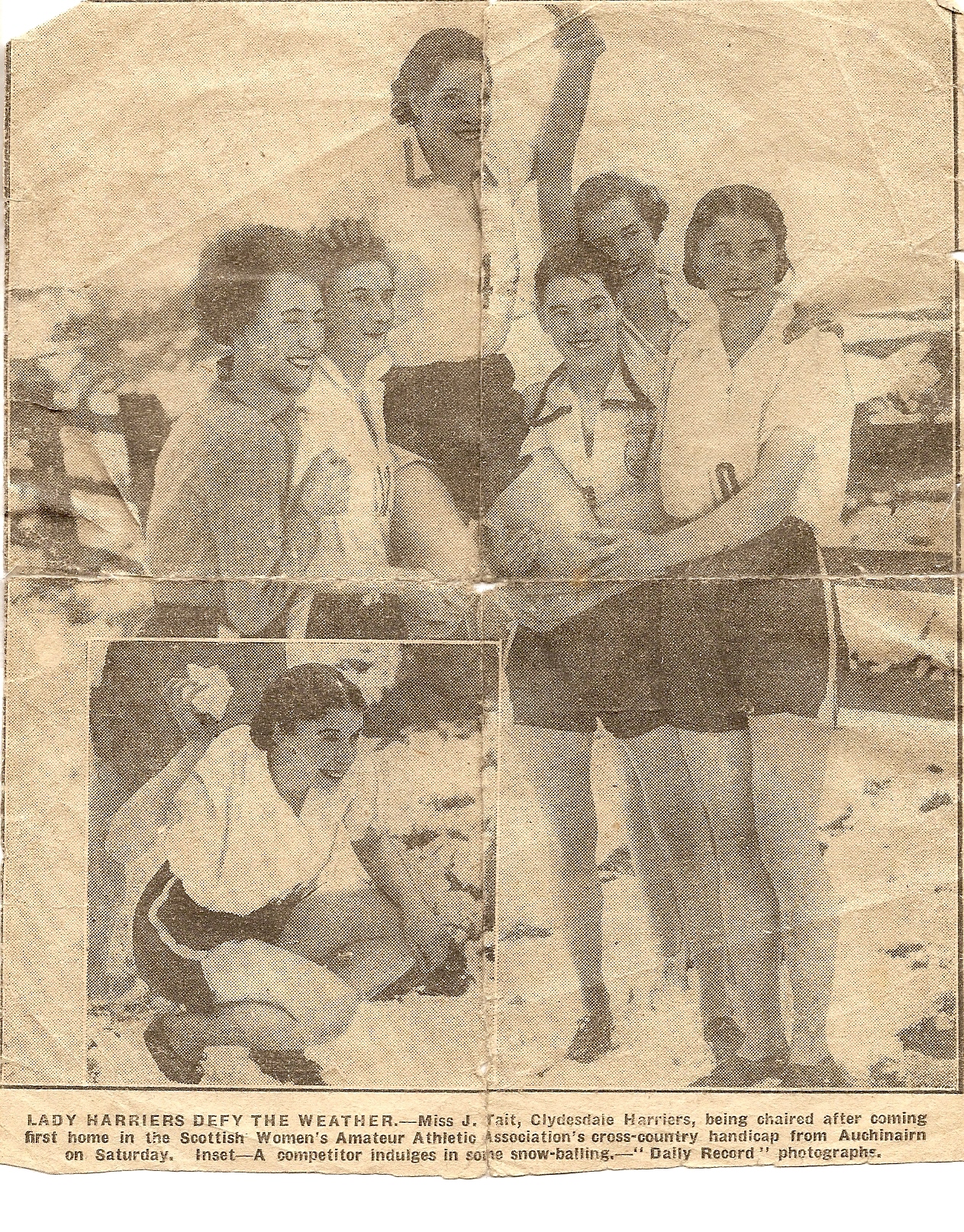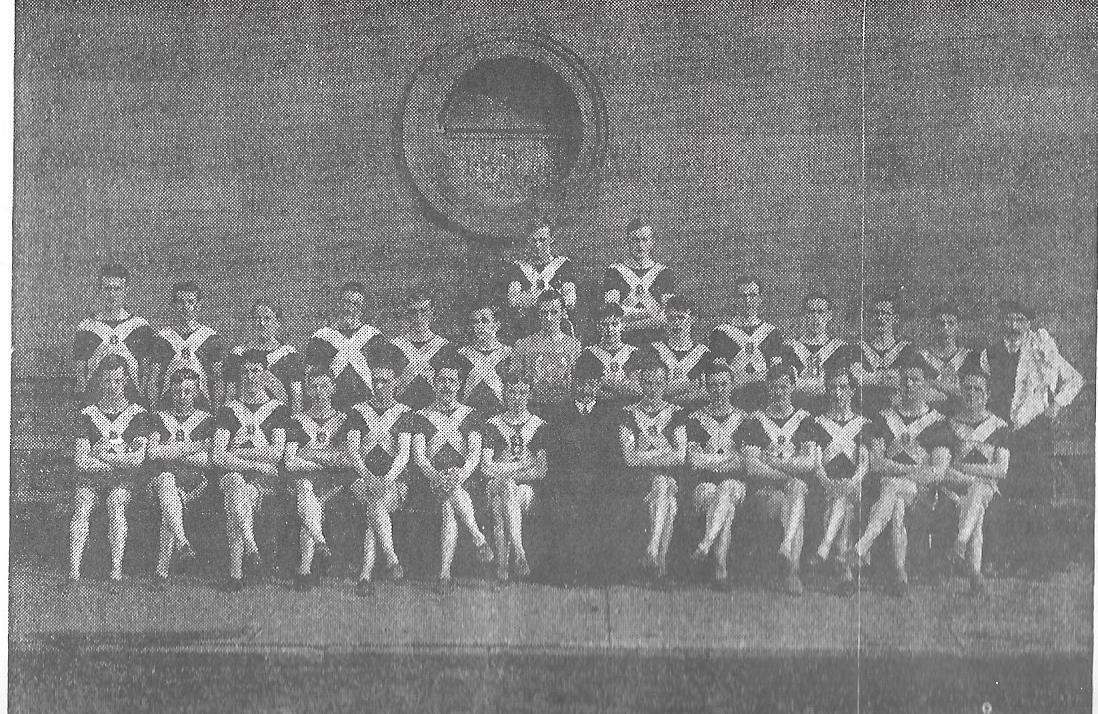
Bellahouston Harriers, 1910
As with the other clubs in this section – Aberdeen AAC, Victoria Park AAC, Hamilton Harriers, etc – this is an account of the beginnings of a club that has achieved a great deal, produced some very good athletes and served the sport well. It is not a history which is too big a subject for a website and in any case it’s not our place to do that. Bellahouston Harriers club centenary history, “From Long Shorts to Short Longs”, written by Robin Sykes was published in 1992 and it was one of the main sources of information for this profile.
Robin tells us that “The club was founded in and around the Govan area of south-west Glasgow and credit for the actual founding goes to John R McDiarmid who was, at the time, Registrar for the neighbouring district of Kinning Park. What is not so clear is the origin of the name. The above named Govan and Kinning Park were districts joined to both Ibrox and Bellahouston. The first training grounds were in those 2 districts before the club moved to the Ibrox area. Since the Bellahouston district, up to this time, seems to have had ‘no part of the action’ it could be that it was finally rewarded with the name. Certainly Govan Harriers, Kinning Park Harriers or Ibrox Harriers just couldn’t compare with BELLAHOUSTON Harriers!
Early training quarters were at Govan Baths for road and cross-country (though occasionally the club made use of Pollok Juniors Football ground at Newlandsfield) and Plantation Street, Kinning Park for Track & Field. The cross-country section remained at Govan Baths until 1929 when they moved to the more up-to-date Pollokshaws Baths (opened in 1925) to be nearer to their traditional training ground of Pollok Park (or Pollok Estate as it was popularly known then. After a few years the track squad moved to Ibrox Station and shortly afterwards moved again, this time to Ibrox Park.”
Since 1892 was the club’s first year, we can start with winter 1892/93. The first cross-country race of any consequence was always the Clydesdale Harriers Seven Miles Cross-Country Individual Handicap and Team Race on the first Saturday in November but the new club did not take part, instead the ‘Glasgow Herald reported that “the five mile handicap of Bellahouston Harriers which fell through some weeks ago owing to the trail being indistinctly marked was brought to a successful issue on Saturday afternoon. The trail layers were Messrs J Allan and W McGuigan, and leaving Ibrox Station at 3:30 they ran out along the Paisley Road, over Bellahouston Estate, skirting Blackwood, on to Bellahouston Home Farm and home by Birnie’s estate and Dumbreck. The competitors were then put in line and set off to a good start. The pace throughout was very hot and the leaders passing and repassing each other time and again. The order in which they passed the judges was:- 1st J Anderson; 2d J McDiarmid; 3d JB Thomson; 4th J Gray; 5th MF Grindlay.” The race referred to was to have been run on 15th October and the occasion was reported in the ‘Glasgow Herald’ which pointed out that the race did start at the Two Mile House on Paisley Road but the runners went off the trail and so the event had been declared ‘null’.
On the first of the intervening weeks, Saturday 22nd October, there was a run from the Two Mile House. The Hares were JB Thomson and J McDiarmid and they set off at 2:55. They laid the trail along the Paisley Road to the Halfway House, then round by the fields to Bellahouston Station, and home by the high road. The slow pack was sent off five minutes later under the guidance of Mr Mal Campbell with Mr J Caldwell as whip. They were followed five minutes later by a fast pack led by Mr E Biggar with Mr W McGuigan as ‘whipper-in’. About a mile from home, the packs were got together and a race for home was organised. First three were Biggar, Grindlay and McGuigan. The running time for the fasts was about 45 minutes.
With very few organised races on the calendar, clubs organised inter-club runs on many of the ‘free’ Saturdays and the first such run noted for this first cross-country season was with Whiteinch Harriers in the west of Glasgow. “Bellahouston and Whiteinch Harriers held a joint run from the Whiteinch Bowling Green on Saturday afternoon. At 3:55 the Hares, Messrs Gray, McDonald, Harley and Yorston, went off with the paper which they strewed down through Scotstoun, along the riverside, up by Scotstounhill, on to Great Western Road, thence to Garscadden Road and home by Dumbarton Road. Two packs were formed and went in pursuit, the slows paced by Mr JW Rice and whipped by Mr JF Grindlay, and the fasts by Messrs W Lauderdale and W McGuigan. The ground was heavy and the going in consequence slow the two packs arriving in a cluster. Time:- hares 41 mins, fasts, slows 43 mins. Distance 6 miles.”
It being Scotland the weather was not always the best and at times it was definitely unhelpful. On 10th December the report read:
“The run on Saturday afternoon was from the Halfway House, Paisley Road, and owing to the very heavy nature of the ground, it was resolved to run in one pack after the trail was laid. The Hares were Messrs Skinner, Rankine and Hall and, setting out at 3:15, they marked out a course of ten miles skirting Blue Bell Wood and Pollokshaws Road, through Torwood and Blackhall, thence home with a straight spin on the Paisley Road. Fifteen minutes later the push started under the guidance of Mr A Glasgow, Mr W McGuigan acting as whipper-in On entering Paisley Road for home a race ensued and the following passed the finishing post in order named: Messrs A Glasgow, HF Grindlay, W McGuigan, Gavin Brand and L McDonald. Times: Hares 80 mins, Pack 70 mins.”
17th December, 1892: “Met at the Two Mile House, Paisley Road on Saturday afternoon to run a trial for the inter-team race next Saturday. At 3:20 the hares, Messrs HF Grindlay, Allen and Anderson, set off with the bags and marked off a representative cross-country route of about ten miles by Netherton Quarries, on to Cardonald Estate, through Williamsburgh, skirting Barrie’s and Pettigrew’s farms, and home by Pollokshaws and Dumbreck. To put all on an equal footing, the intending competitors went off all in one pack under the direction of Mr HM Grindlay, Mr J Gray acting as whip. The first arrivals were Mr J Topping, J Gray, J Robertson, HM Grindlay and G Brand. Time:- Hares 73 minutes, pack 75 minutes. The committee afterwards met and selected the team to represent the club next Saturday as follows:- Messrs K Biggar, J Allan, A Glasgow, J Anderson, W McGuigan and HF Grindlay (captain).”
The report mentions the hares setting off with ‘the bags’… These runs were usually marked by the hares who carried a crescent shaped bag filled with shredded or torn paper tucked under one armpit with a strap over the shoulder to hold it in place. There was an opening at the front from which the paper was extracted and strewn in handfuls over the path that the hares decided to take. The pack, or hounds, was led by a pace who wore a distinctive sash and who had to be give three yards clearance from the pack; the whip, or whipper-in, was at the back of the pack and communicated with the whip informing him to slow down if one of the pack was struggling, or speed up if the pack was finding the pace too easy.
The team race referred to was run on December 24th: “Two Miles Inter-Team Contest. This match, which was down for decision on Saturday, caused considerable interest, as the teams entered were considered to be very evenly balanced, and seeing the race was to be run on the track, it was anticipated that this would enhance the interest as the competitors would be in sight all the time. Four teams competed: Clydesdale Juniors, Greenock and Paisley Juniors. [The runners in all four teams were listed] The race was held at Underhill Park, the ground of Abercorn and, as the track was under repair, only two teams could compete at a time, so the race was run in heats. 1st Heat: Paisley Juniors v Clydesdale Juniors was won by the former by 15 points to 23. The second heat was much slower than the first and was won by Bellahouston with 13 points against Greenock’s 21. The final tie will be run about the end of the season. ”
There was a club five mile run on 15th January and it was a simple pack run from the Two Mile House.
The club did not turn out a team, or indeed any representatives, in the SCCU Junior Championships at the start of February, but the club seven miles open handicap on 25th February but not on any home ground. The report said that they held their 7 miles handicap from the same place as the Queen’s Park Harriers. The Queen’s Park Harriers held their four miles open handicap at Whiteinch. It went on “The trail was laid over fields and water jumps and along the banks of the canal, finishing with a mile on Dumbarton Road. The result was as follows:- 1st Paton 44 mins 55 secs; 2d McKay 45 mins; 3rd McGuigan 45 mins 15 secs; 4th Anderson (scratch) 45 mins 30 secs. The distance would only be between 5 and 6 miles.”
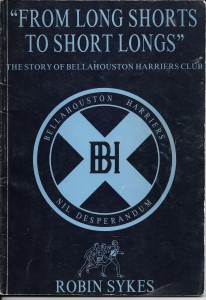
That first winter was fairly typical of a cross-country season in the 1890’s/early 1900’s. There was no Bellahouston Harriers team in theNational Cross-Country championship on the first Saturday in March because most clubs did not enter teams – only four clubs (Clydesdale, Edinburgh Harriers, West of Scotland and Edinburgh Northern) had entered and in 1895 only two teams competed. There were three major races – the Clydesdale Individual and Team Race, The SCCU Junior Championship (later to become the Western District Championships) and the National. The remainder of the winter was taken up by inter-club (or joint) runs, club runs and club championships. Newspaper coverage was variable. The big races were covered and included the English championships, but otherwise it was down to the clubs to submit a short report on their Saturday runs. These ran up to a maximum of about four paragraphs and were printed in a single column under the heading ‘HARRIERS’. Not all clubs used this facility but most submitted reports with a segree of frequency. The regulars in the Glasgow Herald were Edinburgh Harriers, Clydesdale Harriers Greenock Section, Clydesdale Harriers Dumbartonshire Section, Clydesdale Harriers Juniors, Dennistoun Harriers, Paisley Harriers Senior, Paisley Harriers Junior, Whiteinch Harriers and so on. Bellahouston was a fairly frequent poster in this column.
In winter 1893/94 the pattern was much the same except, as you might expect, that there was more interaction with established clubs. The reports up to the end of 1893 had the following on the club fixture list. Only some will be quoted.
October 7th Bellahouston Harriers had their run from Queen’s Park Cafe, Crosshill. Pack of 20 over five miles.
October 16th Joint run with Whiteinch from Half Way House – about 60 members turning out.
October 28th Bellahouston Harriers Five Miles Handicap. The report read: “The rendezvous of the B.H. on Saturday for their first handicap of the season, was Harvey’s Half Way House, Paisley Road. The hares were Messrs W Sinclair, W Wark, T Graham, WA Campbell, RT Morrison and JR Thomson who, setting out at 3:30, showed a distinct trail through Pollok Estate, along the banks of the Cart, skirting Crookston Castle and home by Corkerhill Road – a course which included thoroughly representative country for a race. A quarter of an hour afterwards the competitors were sent on their journey in handicap order, and the scratch men went off at a racing pace, and had got their men about a mile from home. The racing then became very keen, and the first to pass the judges (Messrs James Wilson and J Anderson, vice-captain) were EG Biggar (scratch), Mr W McKay (11 sec) 2d, and Mr W McGuigan 3d. Messra J Madden and W Millar were the first novices in the race, the former with 30 sec start and the latter with 2 min 15 sec. Mr G Brown officiated as starter and timekeeper.”
4 November, 1893, 30 members in a run from the ‘mustering place’ of Harvey’s Half Way House over about 5 miles.
25th November: “MARYHILL HARRIERS: The club had a regular field day at Maryhill, where they had for their guests the Edinburgh Northern (holders of the national junior championship), Western, Queen’s Park, Bellahouston and the Coatbridge section of the Clydesdale Harriers clubs. The rendezvous was the Old School Room, Maryhill, where accommodation was taxed to the utmost to provide stripping room for the large attendance.” Four packs were run with the hares setting out at 3:30 for a trail round the banks of the Kelvin, Acre Road and ending up along Canniesburn Road.
9th December: Joint run with Cairns Harriers from the Gardener’s Hall, Cambuslang.
23rd December: A home run from the Half Way House and two packs ran over seven miles.
30th December: No run was noted but there was a large joint run organised by Queen’s Park and the club may have been represented in that.
6th January, 1894: About 20 members took part in the run which, owing to the snow on the ground and the lack of coloured paper to lay the trail, was done as a single pack along the road to Paisley and back.
13th January: A record attendance covered a trail of about ten miles in two packs.
20th January: The members of B.H. travelled to Crosshill on Saturday for their weekly run, and when they arrived found it would be useless laying a trail as the Clydesdale and the YMCA had both laid paper in the district, so they followed the pack of the latter.”
27th January: “The event on the card for Saturday was the team race, Captain versus Vice-captain, and it turned out a very close and exciting event. …… a very good course leading from the inn across the fields to Cardonald Station, skirting Renfrew towards Crookston, and finishing with a mile and a half on the road. The conditions were:- 12 to run in each team, first 6 to count ……….. on the points being added the vice-captain’s team was found to be the winner with 39 points to the captain’s 41.”
17th February: The Western District Cross-Country Championships. Scottish athletics was notionally divided into two groups – the senior clubs (the oldest clubs such as Clydesdale, West of Scotland, Edinburgh Harriers, Edinburgh Northern, Motherwell YMCA) and the Junior clubs (the rest who were not thought to be of a high enough standard to contest the national championship. The Western District had just been formed and set up these championships for the junior clubs. In this, the first event, Bellahouston Harriers were the winning team. Ten clubs ran over a trail of seven miles and Bellahouston’s first runner was EG Biggar in fourth place. The other runners were W McGuigan sixth, J Anderson ninth, W Sorbie tenth, JR McDermid twelfth, J Paton. These are the actual places as the runners crossed the line, for team scoring places those contestants who did not have a team were discarded and so the actual scoring positions were lower. Nevertheless, the club probably was not too concerned about that since at the age of only two years they had won a championship!
24th February: only 14 runners turned out for a run over a six mile trail.
This brought us back to the national championship at the start of March in which only 4 clubs took part. It had been a good winter for Bellahouston Harriers with the best performance being the victory in the new Western District race with some good packing – five of their six being between fourth and twelfth. The pattern had been as before with more joint runs being included, numbers seemed to be growing and the very young club was gaining in confidence and experience. The continuing habit of having only four or five teams running in the National Championship continued with no signs of it becoming really open in the near future.
Picture from A Wilson
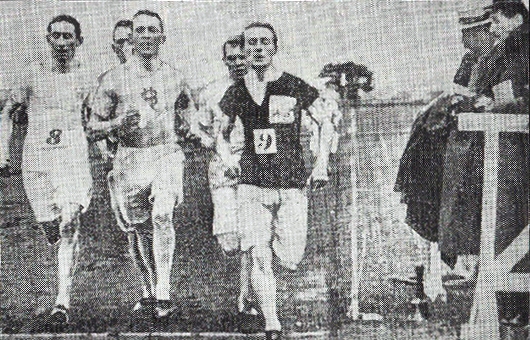
AAA’s Mile 1907. McGouch front and ventre between Robertson (8) and Deakin (9)
Picture from A Wilson
The really big successes for the club over the next few years were individual however rather than team and we can look at some of them now.
The most notable of them all was probably John McGough. There is a proper full-length profile of him available if you click the link buit he was the country’s most outstanding middle distance runner of the period. McGough won the SAAA Mile title in six consecutive years from 1902- 1907, he won the half mile three times and the Four Miles once. In 1903 he actually won all three in the same championships. He represented Scotland in many internationals on the track and ran in the London Olympics in 1905.
The club history claims JV Paterson, Scottish cross-country champion in 1898, ’99 and 1900 as a club member – and he undoubtedly was for several years – but the records (official history, newspaper reports) list his club as Watsonians when he won the three titles. Check the link.
Over the country, several club men represented Scotland in the period up to the war – PC Russell 1905, ’06, JW Templeman 1910, ’11, ’13 and ’14, GR Stevens 1912, ’14, G Cummings 1914, J Lindsay 1914.
JW Templeman was the most prolific. In 1910 there was no Bellahouston Harriers team in the West District championships and there were no runners placed in the first 20 but when the National came along on 5th March Templeman was fifth. The first six placers were : A McPhee (Clydesdale), J Duffy (Edinburgh), T Jack (Edinburgh Southern), G Templeman (BH) & George McKanzie (West of Scotland and A Mann (Clydesdale). The international was to be in Belfast on 26th March and Templeman was fifth Scot to finish for the team that was third. Other Scots were McPhee 8th, Duffy 15th, MacKenzie 16th, Cuthbert 19th, Templeman 20th. Wallach, the top Scot, dropped out. For all his ability, Templeman did not contest the WEest District Championships on 4th February, 1911, at Carntyne Racecourse where the club finished third with the scoring runners being A Craig 3rd, JY McAdam 16th, G Stephen 17th, E Rodger 18th, D Honeyman 51st and W Law 77th. Unfortunately there was no Bellahouston team in the National at Sheep Farm Park, Pollokshaws but Templeman was third to finish nd was selected for the international at Newport later in the month. It was a pity that there was no team from the club on what was pretty well a home trail but the practices of the time prevailed. This time though, Templeman failed to finish on a day that was dry underfoot but with some slight snow falling.
In 1912, 28 teams were entered for the Western District Championships and Bellahouston Harriers went two better than the previous year and won the team race. They had previously won this event twice – in 1896 and in 1901. Again, no Templeman but, again, Archie Craig led the team home in third place with the others being Rodgers, Stephen, Honeyman, McAdam and Law. In the National at Scotstoun, Templeman led the field at the start of the race but faded and the first club runner to finish was Stephen in sixth place followed by Rodger in 12th, Templeman in 18th, Little in 21st, Honeyman 30th and McAdam in 33rd. The team was fourth – 15 points behind Edinburgh Harriers in third. Stephen wasselected for the international and finished creditable 14th and was a scoring runner for the team. In 1913 the Western championships were postponed owing to a heavy snowfall at Scotstoun and they had to be redated. In the event on 15th February, there were no placed runners from the club and the clubitself was not in the first four. But the National Championships in 1913 were to be savoured by Bellahouston runners, friends and supporters – 1st March 1913 was the day they won the national team title. The report read:
“Under favourable weather conditions the cross-country championship of Scotland was decided under the auspices of the National Cross-Country Union of Scotland. The usual five mile course from Scotstoun was selected, beginning and finishing at the Glasgow Agricultural Society’s show grounds, the circuit being covered twice. Seven teams, or one more than last year, were entered, the list being:- West of Scotland Harriers (holders of the team championship), Bellahouston Harriers, Clydesdale Harriers, Edinburgh Harriers, Edinburgh Southern Harriers, Gala Harriers and Monkland Harriers, but Edinburgh Harriers had only two representatives and these ran as individuals, bringing the number of starters in that section to seven. An excellent start was effected and for the first round of the track the men kept together but in the second round they opened up considerably. Passing out of the grounds the lead was taken up by JC Thomson and SS Watt, Clydesdale Harriers, H Hughes and S Mason, West of Scotland, and R Bell, Monkland Harriers, holder of the Western District Championship. At half distance the lead was held by S Watt, who was closely followed by the ultimate winner, A Craig of Bellahouston Harriers, with H Hughes in third position. At this point there was every possibility of a close finish between West of Scotland and Bellahouston, and at the finish the latter secured the victory over the holders by a single point. The following are the placings:-
- Bellahouston Harriers (A Craig 1, A Kerr 5, W Templeman 7, GM Stephen 10, K Rodgers 12, A Mooney 16)
- West of Scotland (G McKenzie 4, H Hughes 6, WG Rodger 8, G Mason 9, D Peat 11, JB Matthews 13)
As a result three Bellahouston Harriers were picked for the international at Juvisy Aerodrome, just outside Paris. All three Bellahouston men were scoring runners for the Scottish team. A Kerr 11th, A Craig 14th and Templeman 18th. The team was third. There were so many firsts for Bellahouston at that point – first club man to win the national, first club team to win the national, first time they had three in the international and all three were counting runners!
1914 was the year when athletics – and much else besides – came to a stop for four years but there was a District an a National Championship run before that. New member James Lindsay from Dreghorn won the individual title in the Western District event with Bellahouston Harriers comfortably winning the team title. The National was again won by the club with a total team score of 29 points, the runners being Craig 1st, Stephens 2nd, Templeman 3rd, Lindsay 5th, G Cummings 6th and W Mathie 12th. Craig had actually been second but Wallach, the winner, was an Anglo-Scot not qualified to count for the team race. Courses at that time were usually ten miles long and both national and international trails for 1914 had plenty of obstacles en route. Two of the Bellahouston runners counted for the Scottish team – Lindsay finished eighth and Craig twelfth – while Stephens did not finish. Colin Shields in “Whatever the Weather” comments: “The outstanding achievements of the domestic season was the breakthrough of James Lindsay of Bellahouston Harriers who proved the most improved runner of the year. Starting the winter season as an unknown, Lindsay’s victory in the Western District Championship promoted him to a “Senior” and be eligible to run in the National Championship. His performance at Carntyne where he finished sixth, was a big surprise. He confirmed this performance with his excellent eighth place in the international where he defeated everyone in the Scots team except the second placed Wallach.”
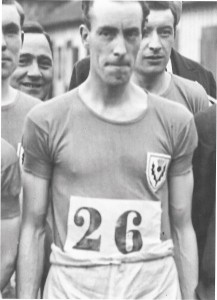
Archie Craig
Picture from A Wilson
Archie Craig was another outstanding club runner whose career spanned the war years but he nevertheless ran in seven cross-countryinternational fixtures as well as winning the title in 1913. There is a complete profile elsewhere on the website. He was known by his nickname od Baldy but Robin Syles explains it for us. Two years after the London Olympics Archie Craig, who was to become a Bellahouston legend, joined the club. ‘Baldy’ as he was dubbed (the ‘a’ being long as in father, not the ‘aw’ in law) was not really bald. It was simply that he plastered his hair down with oil as was the fashion in those days and one can only assume that he plastered it down so much it gave the impression of not being there at all! Baldy became the club’s official first national cross-country champion in 1913.”
There had been three Bellahouston runners in the international team in 1913 and again in 1914 but the first to gain the honour did so eight years earlier. PC Russell however had run for Scotland when he finished second, and first Junior, in the National of 1905. The team was sixth. A month later, in the international at Baldoyle in Dublin, he finished 14th and was a scoring runner for the Scottish team which finished second. Three medals, two gold and one silver, for two races was not a bad end to the season. The following year Russell finished fourth in the National and was picked to run for Scotland at Caerleon in Wales where Scotland slipped back to third position with Russell again a scoring running when he finished in 15th.
The club continued to progress and, in addition to the many top class club team performances,, several very good athletes were produced to grace Scottish athletics. In 1920 at the first national championhip after the war, Bellahouston was third team.
*
This series of articles is headed “In the beginning…” and the intention is to look at the various ways in which clubs sppeared and developed into serious players on the national stage. In this context, the origins of Bellahouston Harriers mirror the development of Scottish athletics from the nineteenth century to the start of the first war. In 1892 there were very few races on the calendar, many more were in evidence by 1914. There were no international fixtures, either track and field or cross-country in 1892 but there were annual internationals in both discilines by 1914. Inter-clubs, joint runs and muster runs were still present in 1914 but not in such big numbers. Thgere were also changes in training methods and running clothing over the period. There is a profile of the road and cross-country activities of the club in the 1945 to 1960 period at this link.
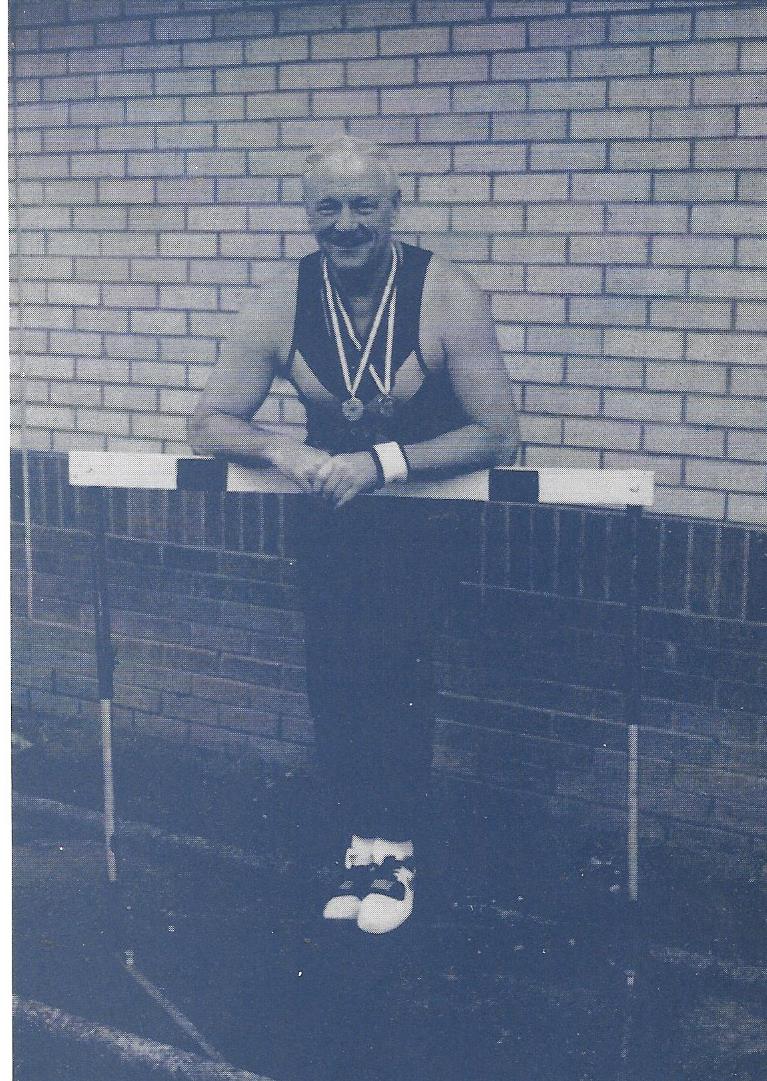
Sources of information for this brief profile were,
- ‘From Long Shorts to Short Longs’ by Robin Sykes. The official centenary of Bellahouston Harriers from which several illustrations have been taken. Robin Sykes (pictured above) took up the sport inthe late 40’s and has been a great club servant winning over 2000 pts in inter-clubs, finalist and medal winner in championships at Scottish and British level, set a Scottish record for the decathlon of 6330 points in 1960. Now 82 years old, he still competres in the Scottish Veterans Field Events Championship.
- ‘A Short History of Bellahouston Harriers, 1892 – 1946’ in ‘The Scots Athlete’ number three by WR McNeillie. He joined the club in 1922 and filled many roles in the administration, notably as Secretary and Treasurer. He also served as an official at many meetings and for a time was one of the handicappers at open meetings.
- ‘Whatever the Weather’ by Colin Shields. This is the official centenary history of the SCCU written by a man who was a runner, an official, an administrator, a historian and reporter to both specialist athletics publications and to the press. Colin was also President of both SAAA and SCCU.
- ’50 Years of Athletics’ ed. K Whitton and DA Jamieson. The 50th anniversary history of the SAAA published by the SAAA in 1933.
- The Glasgow Herald archives for the period.
